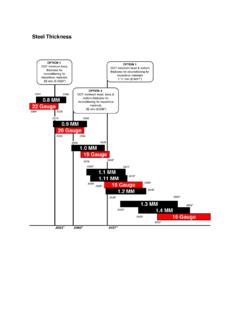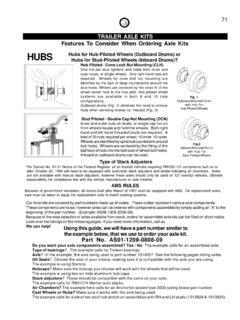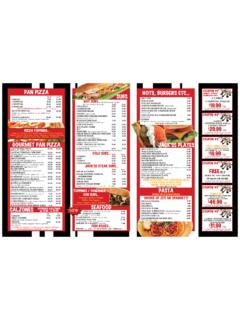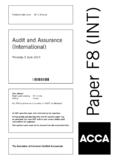Transcription of Ordering Drums for - Mid-America Steel Drum
1 Ordering Drums for Hazardous or Non Hazardous Material Transportation Introduction Selecting the proper Steel drum for your company s needs requires a thorough understanding of the product(s) to be shipped, the transportation environment, applicable regulatory requirements, material handling procedures and the container s viability for reuse. Steel Drums are highly dependable forms of packaging, with many decades of proven performance. When used for the transport of hazardous materials they must meet rigorous performance standards, including; stack, drop, and leakproofness, vibration, and hydrostatic pressure tests that simulate key aspects of the transportation and storage environment.
2 Since the tests represent minimum construction requirements, shippers looking for an extra margin of safety should recognize this fact when formulating their drum specifications. Understanding Performance Marks The Department of Transportation requires all Steel Drums with a capacity greater than 100 liters ( , gallons) used for the transportation of hazardous materials to be performance marked on the bottom and either side or the top head. Nearly all major industrialized nations including the United States have replaced their individual, domestic hazardous materials regulations to comply with the United Nations Recommendations.
3 In the United Nations Recommendations, all hazardous materials are assigned to one of the three relative levels of hazard. These levels of hazard are called Packing Groups and are indicated by Roman numerals as follows: Packing Group I: Great danger (high hazard level) X Packing Group II: Medium danger (medium level) Y Packing Group III: Minor danger (low hazard level) Z The marks on the drum bottom, a sample of which appears below, must be permanent ( embossed). These marks, which remain with the drum throughout its useful life, are known in the drum industry as the birth certificate because they indicate the drum s original performance capability, plus the nominal thickness of the metal expressed in millimeters.
4 UN-Markings Each package that is manufactured and tested in accordance with the performance oriented packaging standards of HM-181 must include a marking on the unit which indicates that the item in fact ahs been UN tested. The next section describes each portion of the UN marking and what it means. Example 2: 4G/X3/S/99/USA/M000 Example of UN Marking for Solid Hazardous Materials: Single or Composite Packaging or Combination Packagings for all materials. The UN symbol in the circle indicates that this container has been UN tested and certified. The DOT packaging regulations requiring Performance-Oriented Packaging (POP), are based on the UN recommendations on the shipment of hazardous materials.
5 With the passage of HM-181 in 1992, the DOT has, for the most part, done away with construction specifications of packaging and has converted to performance-oriented methods, whereby a package is required to pass a series of tests to determine its suitability to package certain materials. Packaging for hazardous materials is now dependent on the hazard classification of a product and its physical attributes. The "UN" marking on the package indicates the level to which the package is tested and passed. How to Read a UN Number or Marking The marking that is applied to a UN certified package indicates the type of package and the levels to which the packaging has been approved.
6 The following describes the sequence of numbers and letters that appear in a UN marking and what they designate. Contents of UN Markings The markings associated with performance criteria indicate the type of package and the levels to which the package has been approved. Each set of information is separated by a slash mark (/). The following explains each set of numbers and letters in the sequence. UN Indication - The package must be marked with a UN Symbol, or just the letters UN are required on embossed metal containers. Packaging Identification Code - This code identifies the type of packaging, the material of construction, and a category within the type when applicable.
7 Packaging Identification Table Type of Package Material Category 1 - Drums 2 - Barrels 3 - Jerricans 4 - Boxes 5 - Bags 6 - Composite Packagings A - Steel B - Aluminum C - Natural Wood D - Plywood F - Reconstituted Wood G - Fiberboard H - Plastic L - Textile M - Paper, Multiwall N - Metal other than Steel xxx or Aluminum P - Glass, Porcelain or xxx Stoneware A, B, or H Drums -Jerricans 1 - Closed Head 2 - Open Head A or B Boxes 1 - Ordinary A or B 2 - A or B w/inner lining or coating C Boxes 1 - Ordinary 2 - w/sift proof walls H Boxes 1 - Expanded Plastic 2 - Solid Plastic L Bags 2 - Sift proof 3 - Water Resistant M Bags 2 - Multi-wall, Water xxx Resistant Example: The Packaging Identification code 1A1 would indicate a drum , made of Steel , with a closed-head configuration.
8 Performance Standard Code - This code identifies the packing group(s) that the package has been tested and approved for. X for Packing Groups I, II, and III Y for Packing Groups II, and, III Z for Packing Group III only Relative Density (Specific Gravity) or Gross Mass - A designation of Specific Gravity or Gross Mass for which the packaging has been successfully tested should follow the Performance Standard Code. a) Stand alone packagings intended to contain liquids must be marked with the specific gravity rounded down to the first decimal. b) Packagings intended for solids or that have inner packagings must be marked with the maximum gross mass (weight) in kilograms.
9 Designation of "S" for Solids or the Hydrostatic Pressure Test Rating in Kilopascals - An "S" in upper case should follow the gross mass to designate that the package is only intended for solids or inner packagings. Single or Composite packagings intended for liquids should reflect the Hydrostatic test pressure in kPa (kilopascals), rounded down to the nearest 10 kPa. Year of Manufacture - The last two digits of data indicate the year the packaging was manufactured. Examples of UN Markings Open Head Steel drum 1A2 USA/+AA0000 3 = Jerrican (square container) Type of Package H = Plastic Material 1 = Closed-Head Category Y = Packing Group (II) Performance Standard Code = Maximum Specific Gravity of Product Relative Density 200 = Kilopascals (kPa)
10 , also referred to as PSI Hydrostatic Pressure Rating 94 = Year container was produced Year of Manufacture USA = Marked under authority of USA +AA0000 = Testing lab identification and test number of container Round Openhead Steel Pail UN1A2/Y23/S/93 USA/+AA1234 1 = drum (round) Type of Package A = Steel Material 2 = Open-Head Category Y = Packing Group (II) Performance Standard Code 23 = Weight in kilograms Gross Mass S = Tested for Solids Solids 93 = Year container was produced Year of Manufacture USA = Marked under authority of USA +AA1234 = Testing lab identification and test number of container 4 = Box Type of Package G = Fiberboard Material Y = Packing Group (II)






![3940 - XK B/sheets[4.6.03]](/cache/preview/8/c/4/e/6/4/4/9/thumb-8c4e6449eb57d3cc5a13b5093db88462.jpg)